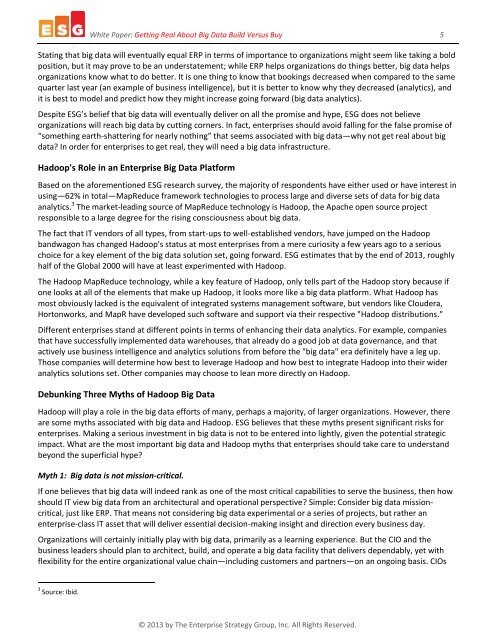esg-big-data-wp-1914112
esg-big-data-wp-1914112
esg-big-data-wp-1914112
You also want an ePaper? Increase the reach of your titles
YUMPU automatically turns print PDFs into web optimized ePapers that Google loves.
White Paper: Getting Real About Big Data Build Versus Buy 5<br />
Stating that <strong>big</strong> <strong>data</strong> will eventually equal ERP in terms of importance to organizations might seem like taking a bold<br />
position, but it may prove to be an understatement; while ERP helps organizations do things better, <strong>big</strong> <strong>data</strong> helps<br />
organizations know what to do better. It is one thing to know that bookings decreased when compared to the same<br />
quarter last year (an example of business intelligence), but it is better to know why they decreased (analytics), and<br />
it is best to model and predict how they might increase going forward (<strong>big</strong> <strong>data</strong> analytics).<br />
Despite ESG’s belief that <strong>big</strong> <strong>data</strong> will eventually deliver on all the promise and hype, ESG does not believe<br />
organizations will reach <strong>big</strong> <strong>data</strong> by cutting corners. In fact, enterprises should avoid falling for the false promise of<br />
“something earth-shattering for nearly nothing” that seems associated with <strong>big</strong> <strong>data</strong>—why not get real about <strong>big</strong><br />
<strong>data</strong>? In order for enterprises to get real, they will need a <strong>big</strong> <strong>data</strong> infrastructure.<br />
Hadoop's Role in an Enterprise Big Data Platform<br />
Based on the aforementioned ESG research survey, the majority of respondents have either used or have interest in<br />
using—62% in total—MapReduce framework technologies to process large and diverse sets of <strong>data</strong> for <strong>big</strong> <strong>data</strong><br />
analytics. 3 The market-leading source of MapReduce technology is Hadoop, the Apache open source project<br />
responsible to a large degree for the rising consciousness about <strong>big</strong> <strong>data</strong>.<br />
The fact that IT vendors of all types, from start-ups to well-established vendors, have jumped on the Hadoop<br />
bandwagon has changed Hadoop's status at most enterprises from a mere curiosity a few years ago to a serious<br />
choice for a key element of the <strong>big</strong> <strong>data</strong> solution set, going forward. ESG estimates that by the end of 2013, roughly<br />
half of the Global 2000 will have at least experimented with Hadoop.<br />
The Hadoop MapReduce technology, while a key feature of Hadoop, only tells part of the Hadoop story because if<br />
one looks at all of the elements that make up Hadoop, it looks more like a <strong>big</strong> <strong>data</strong> platform. What Hadoop has<br />
most obviously lacked is the equivalent of integrated systems management software, but vendors like Cloudera,<br />
Hortonworks, and MapR have developed such software and support via their respective "Hadoop distributions."<br />
Different enterprises stand at different points in terms of enhancing their <strong>data</strong> analytics. For example, companies<br />
that have successfully implemented <strong>data</strong> warehouses, that already do a good job at <strong>data</strong> governance, and that<br />
actively use business intelligence and analytics solutions from before the "<strong>big</strong> <strong>data</strong>" era definitely have a leg up.<br />
Those companies will determine how best to leverage Hadoop and how best to integrate Hadoop into their wider<br />
analytics solutions set. Other companies may choose to lean more directly on Hadoop.<br />
Debunking Three Myths of Hadoop Big Data<br />
Hadoop will play a role in the <strong>big</strong> <strong>data</strong> efforts of many, perhaps a majority, of larger organizations. However, there<br />
are some myths associated with <strong>big</strong> <strong>data</strong> and Hadoop. ESG believes that these myths present significant risks for<br />
enterprises. Making a serious investment in <strong>big</strong> <strong>data</strong> is not to be entered into lightly, given the potential strategic<br />
impact. What are the most important <strong>big</strong> <strong>data</strong> and Hadoop myths that enterprises should take care to understand<br />
beyond the superficial hype?<br />
Myth 1: Big <strong>data</strong> is not mission-critical.<br />
If one believes that <strong>big</strong> <strong>data</strong> will indeed rank as one of the most critical capabilities to serve the business, then how<br />
should IT view <strong>big</strong> <strong>data</strong> from an architectural and operational perspective? Simple: Consider <strong>big</strong> <strong>data</strong> missioncritical,<br />
just like ERP. That means not considering <strong>big</strong> <strong>data</strong> experimental or a series of projects, but rather an<br />
enterprise-class IT asset that will deliver essential decision-making insight and direction every business day.<br />
Organizations will certainly initially play with <strong>big</strong> <strong>data</strong>, primarily as a learning experience. But the CIO and the<br />
business leaders should plan to architect, build, and operate a <strong>big</strong> <strong>data</strong> facility that delivers dependably, yet with<br />
flexibility for the entire organizational value chain—including customers and partners—on an ongoing basis. CIOs<br />
3 Source: Ibid.<br />
© 2013 by The Enterprise Strategy Group, Inc. All Rights Reserved.


